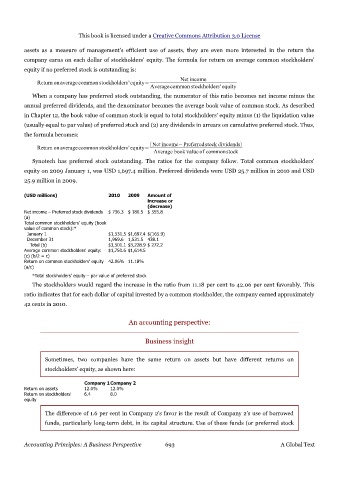Page 692 - Accounting Principles (A Business Perspective)
P. 692
This book is licensed under a Creative Commons Attribution 3.0 License
assets as a measure of management's efficient use of assets, they are even more interested in the return the
company earns on each dollar of stockholders' equity. The formula for return on average common stockholders'
equity if no preferred stock is outstanding is:
Net income
Return onaveragecommon stockholders'equity=
Averagecommon stockholders'equity
When a company has preferred stock outstanding, the numerator of this ratio becomes net income minus the
annual preferred dividends, and the denominator becomes the average book value of common stock. As described
in Chapter 12, the book value of common stock is equal to total stockholders' equity minus (1) the liquidation value
(usually equal to par value) of preferred stock and (2) any dividends in arrears on cumulative preferred stock. Thus,
the formula becomes:
Net income−Preferredstock dividends
Return onaveragecommon stockholders'equity=
Average book value of commonstock
Synotech has preferred stock outstanding. The ratios for the company follow. Total common stockholders'
equity on 2009 January 1, was USD 1,697.4 million. Preferred dividends were USD 25.7 million in 2010 and USD
25.9 million in 2009.
(USD millions) 2010 2009 Amount of
increase or
(decrease)
Net income – Preferred stock dividends $ 736.3 $ 180.5 $ 555.8
(a)
Total common stockholders' equity (book
value of common stock):*
January 1 $1,531.5 $1,697.4 $(165.9)
December 31 1,969.6 1,531.5 438.1
Total (b) $3,501.1 $3,228.9 $ 272.2
Average common stockholders' equity: $1,750.6 $1,614.5
(c) (b/2 = c)
Return on common stockholders' equity 42.06% 11.18%
(a/c)
*Total stockholders' equity – par value of preferred stock
The stockholders would regard the increase in the ratio from 11.18 per cent to 42.06 per cent favorably. This
ratio indicates that for each dollar of capital invested by a common stockholder, the company earned approximately
42 cents in 2010.
An accounting perspective:
Business insight
Sometimes, two companies have the same return on assets but have different returns on
stockholders' equity, as shown here:
Company 1Company 2
Return on assets 12.0% 12.0%
Return on stockholders' 6.4 8.0
equity
The difference of 1.6 per cent in Company 2's favor is the result of Company 2's use of borrowed
funds, particularly long-term debt, in its capital structure. Use of these funds (or preferred stock
Accounting Principles: A Business Perspective 693 A Global Text

